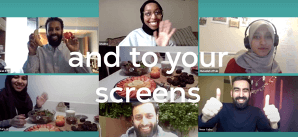Our Thoughts
Together, Apart This Ramadan, how can brands can offer community in distanced times?
This year, religious and cultural celebrations, including Easter and Passover, have faced the unprecedented challenge of the Covid-19 pandemic. Ramadan, the Islamic holy month where Muslims fast between Suhoor (dawn) and Iftar (dusk), is fast approaching. This period is usually characterised by communal prayers, lively evening feasts shared with family and friends and the festive spirit of shared experience. This year, how can brands adapt to offer alternative versions of community, closeness and comfort in a time which limits these cultural tenets?
‘Stay at Home’: Domestic Comfort
Following nationwide lockdowns, the home setting has very suddenly become the sole centre of our daily lives. Whilst usually many Muslims would be continuing daily routines of movement between public spaces, workplaces and Mosques throughout Ramadan, brands must adapt to this cultural shift and communicate an understanding of consumers’ need to “Stay at Home”.
IKEA’s Ramadan range, in collaboration with Lebanese product designer Nada Debs, speaks directly to the current cultural context. The existing homeware brand equity of IKEA communicating the ‘wonderful everyday’ of domesticity is bolstered by their focus on mealtime moments of Ramadan in the collection’s offerings – including serving bowls, jugs and coffee tables.

The products’ visual cues of hexagonal geometric shapes and tiered formats echo the patterns of Islamic architecture, whilst floor cushions signal an understanding of shared Iftar feasts arranged on the floor – coding an authentic cultural engagement with Middle Eastern tradition. Tealight holders and lanterns connote light, foregrounding its centrality to the fast’s dawn-to-dusk structure, with the campaign’s linguistic cues promising a ‘mood-boosting’ Ramadan of ‘family feasts’ – a beacon of uplifting comfort and family focus in these difficult times. Brands can employ these culturally sensitive cues in communications during this period to demonstrate empathy and adaptability for Muslim audiences experiencing a homebound Ramadan.
‘Stay Connected’: Digital Community
The present social isolation rules compromise Ramadan’s cultural notions of communal, interpersonal cohesion. Physical gatherings are no longer an option for the celebration of shared Suhoor and Iftar meals or gift buying and giving – however brands can employ alternative digital cues to recreate a sense of solidarity.
At a time where technology is relied upon to maintain communication, various online arenas offer differing scales of connectivity – mimicking levels of social interaction. For example, the increased use of the Instagram Livestream feature, including by brands like Nike and Glossier. The advertisements of products and services to global online audiences signals a cultural desire to remain commercially connected despite physical confinement. This is especially pertinent to people relying on online advertising and offers as their only domain for buying Ramadan and Eid gifts. Employing this cue of digital connectivity in the Ramadan cultural context will enable brands to sustain real-time engagement with the differing needs of their consumers throughout the month.
Beyond recreating a sense of commercial proximity, brands can also borrow cues of virtual community and shared benefit to strike personal connections with their consumers. Organisations such as the Ramadan Tent Project usually arrange mass ‘Open Iftar’ celebrations in city locations across the UK, bringing inter-faith communities together. This year, RTP have adapted by running open Iftars via Zoom – an online videochat platform enabling up to 100 people to connect per meeting. The capacity for Zoom to create a digital congregation signals a commitment to keeping the spirit of shared experience intact. Brands should consider the use of such online platforms connoting the open connectivity of physical, peer-to-peer meetings to maintain codes of cross-community cohesion and unity.

The upcoming Ramadan month poses a challenging but exciting time for brands to adapt to the current cultural context. Whilst last year saw many brands, such as Ladurée and Burberry, move towards more emergent spaces of luxury eating and premium modest fashion to reach younger, exclusive Muslim demographics, this year calls for a shift towards wider inclusivity and emotional connectivity. Amidst drastic changes to the accustomed ‘normal’, brands can draw on cues of domestic comfort as well as utilising digital space in the absence of physical interaction to maintain community and cohesion this Ramadan and beyond.
Lailah Choudhry, Semiotician

